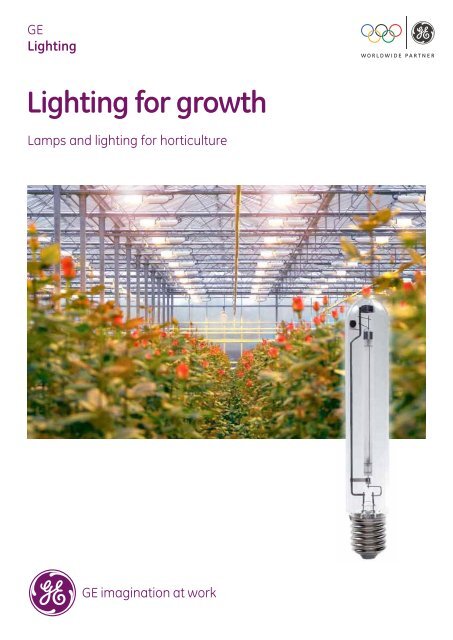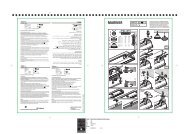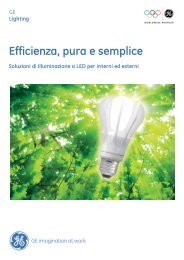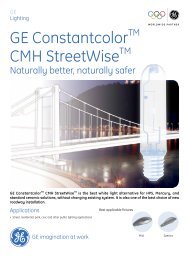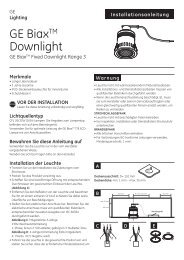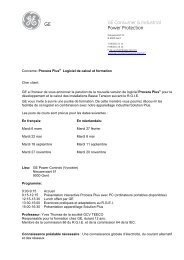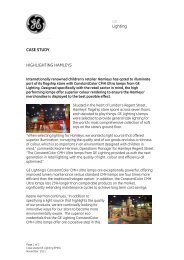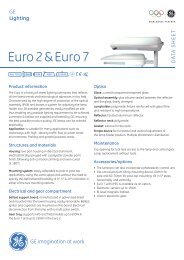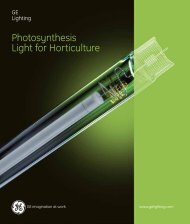Horticulture Lighting - Brochure - GE Lighting
Horticulture Lighting - Brochure - GE Lighting
Horticulture Lighting - Brochure - GE Lighting
You also want an ePaper? Increase the reach of your titles
YUMPU automatically turns print PDFs into web optimized ePapers that Google loves.
<strong>GE</strong><br />
<strong>Lighting</strong><br />
<strong>Lighting</strong> for growth<br />
Lamps and lighting for horticulture
Extending daylight<br />
Growth and development of plants<br />
and vegetables is strongly influenced<br />
by the quality and amount of light<br />
they receive, and the cycle of day and<br />
night. Artificial lighting therefore plays<br />
a significant role in the horticultural<br />
industry, where it enables producers to<br />
extend and control the periods of plant<br />
growth. <strong>GE</strong> horticultural lamps allow<br />
growers to be less reliant on daylight<br />
and improve their productivity.<br />
2<br />
PAR<br />
Photosynthesis Active Radiation (PAR,<br />
measured in micromole/sec) is essential<br />
for plant growth. <strong>GE</strong> Lucalox PSL<br />
(PhotoSynthesis Light) high pressure<br />
sodium lamps are designed to produce the<br />
best possible PAR performance and this<br />
performance is covered by warranty.<br />
Spectral range<br />
Plants respond to light of varying colour. In<br />
general, red light causes plants to become<br />
tall and “leggy” while blue light, when<br />
used alone, can cause low, stocky growth.<br />
A proper balance of red and blue energy<br />
produces plants that have normal growth<br />
and shape.<br />
Relative sensitivity<br />
l <strong>GE</strong> lamps enable<br />
lighting regimes that<br />
assist the natural<br />
cycles of plants<br />
l <strong>GE</strong> horticultural lamps<br />
are colour balanced<br />
for growth and shape<br />
1<br />
0.5<br />
0<br />
PAR in relation to wavelength.<br />
Wavelength<br />
nm<br />
Plants have different sensitivity to<br />
different wavelengths.
<strong>GE</strong> lighting<br />
for fruit and<br />
vegetables<br />
Growers of food plants find artificial light<br />
just as important as it is for flowering<br />
plants. Artificial light can improve the<br />
yield of a crop, and its quality. As with<br />
flowering plants, it enables growth to be<br />
timed to meet market demands.<br />
When an artificial lighting regime is<br />
applied to food crops, these are some of<br />
the benefits:<br />
l Plants can be used over a<br />
longer period<br />
l In winter, fruit can be produced with<br />
taste to match summer fruit<br />
l Production can start earlier<br />
l Year-round cultivation is possible<br />
It is therefore possible for growers<br />
to enhance product quality and take<br />
advantage of marketing opportunities<br />
throughout the year.<br />
Effect on plants<br />
UV-B<br />
UV-A<br />
BLUE<br />
GREEN<br />
RED<br />
IR<br />
(Far-red)<br />
280-320 nm<br />
Deleterious for growth.<br />
320-400 nm<br />
Might have additive<br />
effect to blue radiation.<br />
400-500 nm<br />
Necessary for<br />
elongation control.<br />
500-600 nm<br />
Less important in<br />
photosynthesis than<br />
red spectral range for<br />
certain plants.<br />
600-700 nm<br />
Optimisation is<br />
necessary because<br />
unoptimised<br />
red portion will<br />
cause abnormal<br />
development.<br />
700-750 nm<br />
Enhancement of<br />
flowering & stem<br />
elongation.<br />
Research examples<br />
Cucumber<br />
Blue only or green only irradiation did not<br />
cause development. Optimal growth was<br />
found when the irradiation of the plants<br />
contained 15-20% blue irradiation, rest of<br />
the spectrum was balanced with green<br />
and red irradiation.<br />
Tomato<br />
High productivity requires the dominance<br />
of the 600nm-700nm red part in<br />
irradiation spectrum. Saturation of the<br />
crop yield was achieved with 60-65% red<br />
irradiation, the rest of the spectrum was<br />
balanced by blue and green irradiation.<br />
Reference:<br />
Prikupets & Tikhomirov, proceedings of<br />
Int. <strong>Lighting</strong> in controlled environments<br />
workshop, Univ of Wisconsin, Madison,<br />
Wisconsin, 1994, p31<br />
3
Nature’s rhythms<br />
The relative length of day and night and the seasons is important to plants.<br />
The number of hours of darkness in a 24-hour cycle is an important factor in<br />
determining blossoming and growing time.<br />
Photoperiodism<br />
Night length triggers seed germination, tuber and bulb formation, and other<br />
growth characteristics such as colour, enlargement of leaves and stem size and<br />
shape. This rhythmic characteristic is called photoperiodism and is of great value<br />
to growers.<br />
Plants can be classified according to photoperiodicity.<br />
l Short day (long night)<br />
l Long day (short night)<br />
l Indeterminate or day neutral<br />
4<br />
Short day<br />
(long night)<br />
Long day<br />
Day neutral<br />
The perennial Chrysanthemum and the Poinsettia, which<br />
flower in the autumn, are examples of short-day (longnight)<br />
plants. They fail to flower when the day length, or<br />
period of light, is extended beyond a critical value.<br />
Long-day plants, such as the China Aster and Tuberous<br />
Rooted Begonia, flower only with a day length longer<br />
than a critical value.<br />
Day-neutral plants, such as the Rose and<br />
Carnation are not limited by photoperiod.<br />
Understanding these principles enables commercial growers to use artificial light<br />
profitably, so that flowering and vegetable harvesting can be timed for markets.<br />
Day length<br />
Short day length<br />
The Perennial Chrysanthemum is a short<br />
day length plant that will not flower when<br />
the day is long (short-night). To postpone<br />
flowering Chrysanthemum growers, instead<br />
of lengthening the day, interrupt the night<br />
for about four hours. This makes the night<br />
appear short to plants, which then continue<br />
to grow vegetatively instead of starting<br />
to flower.<br />
A more economical method of postponing<br />
flowering of chrysanthemums is to apply<br />
cycles of light, switching light on for 10<br />
minutes and off for 50 minutes, for four<br />
hours during the night, instead of applying<br />
light continuously. This is cyclic lighting. It<br />
is an effective way of growing flowers. If<br />
lighting levels are higher then the grower<br />
will see better stem and flower quality and<br />
less opportunity for disease.<br />
Long day length<br />
The China Aster is a typical long-day<br />
(short-night) plant. Long-day plants can<br />
be brought to flower ahead of the normal<br />
time by lengthening the day. Relatively low<br />
intensities of light are enough to induce<br />
flowering, when applied early in the morning<br />
or at the end of the day. A dark-period<br />
interruption - from a few minutes to a<br />
few hours - as with other long-day plants,<br />
effectively induces flowering just as it<br />
inhibits flowering of short-day plants.<br />
Poinsettias must have complete and<br />
continuous darkness for about 12 hours a<br />
day in order to flower. Even 1 minute of light<br />
in the middle of the dark period will prevent<br />
their flowering.<br />
Tuberous Begonias flower only when daily<br />
dark periods are short - less than 12 hours -<br />
but they require long dark periods for best<br />
production of tubers. Flowering of tomatoes,<br />
however, is not influenced by photoperiod.
Plant colour and<br />
leaf formation<br />
Photoperiod also influences plant<br />
responses such as colour and<br />
formation of the leaves.<br />
Coleus, for example, under continuous<br />
lighting, produces dark red leaves with<br />
bright green edges. Less than 10 hours<br />
of light per day results in less sturdy<br />
plants and paler colours. The tulip bulb<br />
is the main source of food reserve,<br />
and the light is needed mainly to<br />
develop the plants’ green colour. Stems<br />
attain their greatest length if grown<br />
under lighting.<br />
Setting the clock<br />
Artificial light can be used in a variety of lighting regimes.<br />
EXTEND EXTEND<br />
ADD<br />
SUBSTITUTE<br />
As an additional<br />
daytime source of<br />
light, boosting existing<br />
light levels and aiding<br />
photosynthesis.<br />
As an extension to the<br />
growing season through<br />
usage during the winter<br />
months.<br />
As a means of<br />
extending the growth<br />
time per day. Lights<br />
can be switched on<br />
at dusk or other non<br />
daylight hours.<br />
As a complete natural<br />
light substitute for total<br />
environmental control<br />
in growing rooms and<br />
biological research<br />
establishments.<br />
5
Quality from start to finish<br />
<strong>GE</strong> horticulture lamps have a long history of manufacture in the Budapest light source<br />
factory in Hungary. Quality is a fundamental part of all lamp manufacture but in<br />
particular the manufacture of horticulture lamps, where users rely on the lamp as a<br />
critical production tool.<br />
Automated testing process<br />
Testing spheres<br />
Long t erm t esting r acks<br />
6<br />
High quality components are used in<br />
all aspects of manufacture to ensure<br />
consistent lamp to lamp performance.<br />
Arc tube production takes place<br />
in an argon box which ensures a<br />
clean environment so there is no<br />
contamination and seal protection<br />
ensures the lamps do not fail early.<br />
At the end of the manufacturing process<br />
every lamp is tested and samples from<br />
every production run are placed on<br />
long term testing racks. Light output is<br />
measured in spheres to ensure lamps<br />
meet specification.
Reliable performance 60<br />
Reliability (%)<br />
Relative PAR maintenance (%)<br />
PSL data<br />
Typical lamp survival<br />
100<br />
95<br />
90<br />
85<br />
80<br />
75<br />
70<br />
65<br />
60<br />
55<br />
50<br />
0 2 4 6 8 10 12<br />
Life (thousand hours)<br />
Typical PAR maintenance<br />
100<br />
95<br />
90<br />
85<br />
80<br />
75<br />
70<br />
65<br />
60<br />
55<br />
50<br />
0 2 4 6 8 10 12<br />
Life (thousand hours)<br />
While light quality is paramount,<br />
reliability and performance have<br />
also been key factors in the<br />
development of the Lucalox PSL<br />
lamp range.<br />
Guaranteed<br />
<strong>GE</strong> is constantly engaged in a global<br />
quality process. A statistical quality<br />
system, designated SIX SIGMA, is<br />
applied in all areas of the company from<br />
manufacturing through to sales.<br />
<strong>GE</strong> offers warranties to distributors of<br />
its <strong>GE</strong> brand 230V 250W, 400W, 600W,<br />
and 750W and 400V 600W and 750W<br />
Lucalox PSL (PhotoSynthesis Light) High<br />
Pressure Sodium lamps.<br />
The lamps comply with the IEC/EN 62035<br />
standards, and are in accordance with the<br />
specifications set out in the <strong>GE</strong> Consumer<br />
& Industrial - <strong>Lighting</strong> Spectrum Lamp<br />
catalogue, and in the “Lucalox PSL,<br />
PhotoSynthesis Light Lamp” brochure.<br />
The warranty comprises two parts:<br />
l Warranty on Lamp Reliability<br />
(Lamp Survival)<br />
l Warranty on PAR (Photosynthesis<br />
Active Radiation) Maintenance<br />
Reliability (%)<br />
Relative PAR maintenance (%)<br />
Typical lamp survival<br />
100<br />
95<br />
90<br />
85<br />
80<br />
75<br />
70<br />
65<br />
55<br />
50<br />
0 2 4 6 8 10 12<br />
Life (thousand hours)<br />
100<br />
95<br />
90<br />
85<br />
80<br />
75<br />
70<br />
65<br />
60<br />
55<br />
50<br />
PSL data<br />
Typical PAR maintenance<br />
0 2 4 6 8 10 12<br />
Life (thousand hours)<br />
Robust construction, reliable starting<br />
technology and improved lumen<br />
maintenance ensure peace of mind<br />
against early lamp failures and provide<br />
the consistency demanded for perfect<br />
growing conditions.<br />
Packed for<br />
convenience<br />
Production quality is important, but <strong>GE</strong><br />
also ensures that lamps reach users in the<br />
condition in which they left the factory, and<br />
packaged for users’ convenience.<br />
Bulk Pack<br />
Lamps are available in a time-saving<br />
bulk pack for easy installation on site<br />
and transporting used lamps to recycling<br />
centres. The sturdy recycled cardboard pack<br />
has carrying handles, and is provided at<br />
no extra cost. Lamps are also still available<br />
in 12 packs for smaller installations or<br />
replacements.<br />
63 lamps/box<br />
12 boxes/pallet<br />
7
The Lucalox PhotoSynthesis Lamp<br />
PSL technology<br />
Superb performance and high reliability:<br />
- <strong>GE</strong>’s advanced sodium resistant ceramic<br />
helps eliminate early failures to give a<br />
rated service life of 10,000 to 12,000 hours<br />
for Lucalox PSL products.<br />
- In order to achieve maximum<br />
performance, <strong>GE</strong> recommends lamp<br />
replacement when the Rated Service Life<br />
is reached.<br />
- The lamps use extra rugged monolithic arc<br />
tubes equipped with <strong>GE</strong> Reliable Starting<br />
Technology which provides continuous<br />
high performance.<br />
8<br />
l Specially developed for<br />
horticulture<br />
l Provide an average<br />
5% additional PAR<br />
(Photosynthesis<br />
Active Radiation) over<br />
standard HPS lamps<br />
l Stable PAR<br />
maintenance<br />
l 250W, 400W, 600W<br />
and 750W<br />
High xenon-fill gas delivers:<br />
- Extra light and PAR<br />
(Photosynthesis Active Radiation) output.<br />
- More resistance to mains voltage<br />
fluctuations.<br />
Zirconium gettering system improves PAR<br />
maintenance that drives constant and<br />
uniform plant growth.<br />
- The diameter of the frame wire in the lamp<br />
has been minimised to reduce shading<br />
in the installation without affecting the<br />
robustness of the lamp.<br />
- Monolithic arc tube construction for<br />
durability and lumen maintenance.<br />
Code Volts Current Power 100 hour 100 hour PAR<br />
V A W Lumens μmole/sec<br />
LU250W/PSL 115 2.7 250 33,000 430<br />
LU400W/PSL 110 4.3 420 56,500 710<br />
LU600W/PSL 115 6.0 615 90,000 1080<br />
LU750W/PSL 115 7.4 755 112,000 1320<br />
LU400V/600W/PSL 200 3.6 620 85,000 1120<br />
LU400V/750W/PSL 205 4.4 765 104,000 1390<br />
Specially developed for greenhouses,<br />
Lucalox PSL high pressure sodium<br />
lamps offer the benefits of stable lumen<br />
and micromole maintenance and a<br />
full spectrum content that promotes<br />
photosynthesis. Photosynthesis Active<br />
Radiation (PAR, measured in micromole/<br />
sec) is essential for plant growth.<br />
Lucalox is available in four wattages,<br />
250W, 400W, 600W and 750W.<br />
Simple light or lumen maintenance is not<br />
enough to create plant growth. Plants<br />
require a certain radiation level to help<br />
with photosynthesis. The Lucalox PSL<br />
lamp has been specially developed to<br />
provide stable lumen maintenance and<br />
increased PAR output.
(PSL) range<br />
What is PAR ?<br />
The effect of optical radiation on plants<br />
has been studied extensively; generally,<br />
photons emitted in the spectral region of<br />
400nm-700nm are particularly effective.<br />
Therefore the simple measurement<br />
of quantity of light - Lux - is not<br />
sufficient for the horticultural market.<br />
Photosynthetically Active Radiation (PAR)<br />
and Photosynthetic Photon Flux (PPF), are<br />
more useful measurements. PPF is defined<br />
as flux of the photons emitted in the 400<br />
nm-700 nm wavelength range by the light<br />
source. It is expressed in micromoles/<br />
second (μmol/s), where 1 micromole<br />
means 6x10 17 photons.<br />
HPS - the natural choice<br />
Different lamp types have different<br />
spectral output characteristics as well<br />
as different PPF/W efficiencies. The<br />
most commonly used lamp type in the<br />
horticultural market is High Pressure<br />
Sodium (HPS) due to its favourable PPF/W<br />
value, low early and mid life failure rate,<br />
and its close to flat PAR maintenance<br />
over it useful life. The HPS PSL range from<br />
<strong>GE</strong> has specially optimised spectra for<br />
greenhouse use, by enhancing the red<br />
portion of its light output.<br />
This means that HPS lamps designed for<br />
the horticulture market can have lower<br />
light level (lumen) in the visible spectral<br />
range compared to HPS lamps designed<br />
for street lighting. Despite a lower initial<br />
lumen level, HPS PSL lamps, are perfectly<br />
suited to horticulture.<br />
PPF/W<br />
Spectral power [W/nm]<br />
2.0<br />
1.6<br />
1.2<br />
0.8<br />
0.4<br />
0<br />
7.0<br />
6.0<br />
5.0<br />
4.0<br />
3.0<br />
2.0<br />
1.0<br />
LFL<br />
SOX<br />
Halogen<br />
Incandescent<br />
CMH<br />
HPS<br />
High Pressure Mercury<br />
0 100 200 300 400 500 600 700 800<br />
Nominal Watts<br />
The PSL spectrum<br />
LU400/PSL<br />
The spectral distribution of a typical Lucalox lamp shows that light is<br />
emitted in the wavelengths best suited to plant growth.<br />
380 430 480 530 580 630 680 730<br />
Wavelength [nm]<br />
9
230V<br />
The new 250W addition to the range is<br />
ideal for use in between crops or for crops<br />
that require lower light levels.<br />
Supply voltage<br />
Suitable for supplies in the range 220V to<br />
250V 50/60Hz for appropriately rated series<br />
choke (reactor) ballasts.<br />
Spectral power [W/nm]<br />
The Lucalox PhotoSynthesis Lamp<br />
250W<br />
Code V A W 100 h 100 h<br />
PAR<br />
Lumens μmole/<br />
sec<br />
LU250W/PSL 115 2.7 250 33,000 430<br />
Runup times<br />
140%<br />
120%<br />
100%<br />
80%<br />
60%<br />
40%<br />
20%<br />
140%<br />
120% 4.5<br />
100% 4.0<br />
3.5 80%<br />
3.0 60%<br />
2.5 40%<br />
2.0 20%<br />
1.50%<br />
1.0<br />
0.5<br />
0.0<br />
0%<br />
160%<br />
140%<br />
120%<br />
100%<br />
1080%<br />
60%<br />
LU250PSL<br />
0 200 400 600 800 1000<br />
Time [s]<br />
Spectra<br />
LU400PSL<br />
LU250/PSL<br />
Power<br />
Lamp voltage<br />
Current<br />
PAR<br />
Power<br />
Lamp voltage<br />
Current<br />
PAR<br />
0 200 400 600 800 1000<br />
Time [s]<br />
380 430 480 530 580 630 680 730<br />
LU600PSL<br />
Wavelength [nm]<br />
Power<br />
Lamp voltage<br />
Lamp power<br />
Depending on system conditions, lamp<br />
power can vary by ±2.5%.<br />
Ballasts<br />
It is essential to use a ballast appropriate to<br />
the supply voltage at the luminaire.<br />
140%<br />
400W<br />
120%<br />
140%<br />
600W<br />
120%<br />
80%<br />
80%<br />
Code<br />
60%<br />
40%<br />
V A W 100 h 100 h<br />
Power PAR<br />
Lamp voltage<br />
Lumens Current μmole/<br />
Code<br />
60%<br />
40%<br />
V A W 100 h 100 h<br />
Power<br />
PAR<br />
Lamp voltage<br />
Lumens Current μmole/<br />
20%<br />
LU400W/PSL<br />
0%<br />
0 200<br />
110 4.3 420<br />
400 600<br />
Time [s]<br />
PAR<br />
56,500<br />
800<br />
sec<br />
710<br />
1000<br />
20%<br />
LU600W/PSL<br />
0%<br />
0 200<br />
PAR<br />
115 6.0 615 90,000<br />
400 600 800<br />
Time [s]<br />
sec<br />
1080<br />
1000<br />
140% 7.0<br />
120%<br />
6.0<br />
100%<br />
Spectral power [W/nm]<br />
100%<br />
140%<br />
120%<br />
100%<br />
80%<br />
60%<br />
40%<br />
20%<br />
0%<br />
160%<br />
80% 5.0<br />
60%<br />
4.0<br />
40%<br />
20% 3.0<br />
0%<br />
2.0<br />
1.0<br />
0.0<br />
140%<br />
120%<br />
100%<br />
80%<br />
60%<br />
LU250PSL<br />
LU400PSL<br />
0 200 400 600 800 1000<br />
Time [s]<br />
LU600PSL<br />
LU400/PSL<br />
Power<br />
Lamp voltage<br />
Current<br />
PAR<br />
Power<br />
Lamp voltage<br />
Current<br />
PAR<br />
0 200 400 600 800 1000<br />
Time [s]<br />
380 430 480 530 580 630 680 730<br />
Wavelength LU750PSL [nm]<br />
Power<br />
Lamp voltage<br />
120% 10.0<br />
9.0<br />
100%<br />
Spectral power [W/nm]<br />
140%<br />
120%<br />
100%<br />
80%<br />
60%<br />
40%<br />
20%<br />
0%<br />
100%<br />
160%<br />
140%<br />
120%<br />
100%<br />
80%<br />
60%<br />
40%<br />
20%<br />
0%<br />
140%<br />
8.0<br />
80%<br />
7.0<br />
60%<br />
6.0<br />
40%<br />
5.0<br />
20% 4.0<br />
3.0 0%<br />
2.0<br />
1.0<br />
0.0<br />
160%<br />
140%<br />
120%<br />
100%<br />
80%<br />
60%<br />
40%<br />
LU250PSL<br />
0 200 400 600 800 1000<br />
Time [s]<br />
LU400PSL<br />
LU600PSL<br />
0 200 400 600 800 1000<br />
Time [s]<br />
LU750PSL<br />
Power<br />
Lamp voltage<br />
Current<br />
PAR<br />
Power<br />
Lamp voltage<br />
Current<br />
PAR<br />
Power<br />
Lamp voltage<br />
Current<br />
PAR<br />
0 200 400 600 800 1000<br />
Time [s]<br />
380 430 480 530 580 630 680 730<br />
LU600/400PSL<br />
Wavelength [nm]<br />
Power<br />
Lamp voltage<br />
Current
140%<br />
120%<br />
100%<br />
(PSL) range<br />
40%<br />
120% Supply voltage<br />
Suitable for supplies in the range 390V to<br />
80%<br />
420V 50Hz for appropriately rated series<br />
60%<br />
choke (reactor) ballasts.<br />
160%<br />
160%<br />
140%<br />
140%<br />
750W 600W 750W<br />
140%<br />
120%<br />
100%<br />
80%<br />
Code<br />
60%<br />
V A W 100 h 100 h<br />
Power<br />
Lamp voltage<br />
PAR<br />
40%<br />
Lumens Current μmole/<br />
20%<br />
PAR sec<br />
LU750W/PSL 0%<br />
115 7.4 755 112,000 1320<br />
0 200 400 600<br />
Time [s]<br />
800 1000<br />
140%<br />
12.0<br />
120%<br />
100%<br />
10.0<br />
80%<br />
Spectral power [W/nm]<br />
80%<br />
60%<br />
20%<br />
0%<br />
140%<br />
120%<br />
100%<br />
80%<br />
60%<br />
40%<br />
20%<br />
0%<br />
140%<br />
120%<br />
100%<br />
80%<br />
60%<br />
40%<br />
20%<br />
0%<br />
160%<br />
60% 8.0<br />
40%<br />
20% 6.0<br />
0%<br />
4.0 0 200 400 600 800 1000<br />
2.0<br />
0.0<br />
160%<br />
140%<br />
120%<br />
100%<br />
80%<br />
60%<br />
0 200 400 600 800 1000<br />
Time [s]<br />
LU400PSL<br />
0 200 400 600 800 1000<br />
Time [s]<br />
LU600PSL<br />
LU750PSL<br />
0 200 400 600 800 1000<br />
Time [s]<br />
LU600/400PSL<br />
LU750/PSL<br />
Time [s]<br />
Power<br />
Lamp voltage<br />
Current<br />
PAR<br />
Power<br />
Lamp voltage<br />
Current<br />
PAR<br />
Power<br />
Lamp voltage<br />
Current<br />
PAR<br />
Power<br />
Lamp voltage<br />
Current<br />
PAR<br />
380 430 480 530 580 630 680 730<br />
LU750/400PSL<br />
Wavelength [nm]<br />
Power<br />
Lamp voltage<br />
0 200 400 600 800 1000<br />
Time [s]<br />
400V<br />
Spectral power [W/nm]<br />
140%<br />
120%<br />
100%<br />
80%<br />
60%<br />
40%<br />
20%<br />
0%<br />
160%<br />
140%<br />
100%<br />
40%<br />
20%<br />
0%<br />
120%<br />
100%<br />
Code 80%<br />
V A W 100 h 100 h<br />
60%<br />
Power<br />
PAR<br />
40%<br />
Lumens Lamp voltage μmole/<br />
Current sec<br />
LU400V/600W/PSL 20%<br />
200 3.6 620<br />
PAR<br />
85,000 1120<br />
0%<br />
160%<br />
140%<br />
120%<br />
100%<br />
80%<br />
60%<br />
40%<br />
20%<br />
7.0<br />
140%<br />
120%<br />
6.0<br />
100%<br />
5.0<br />
80%<br />
4.0 60%<br />
40%<br />
3.0<br />
20%<br />
2.0 0%<br />
1.0<br />
0.0<br />
LU600PSL<br />
0 200 400 600 800 1000<br />
Time [s]<br />
LU750PSL<br />
0 200 400 600 800 1000<br />
Time [s]<br />
LU600/400PSL<br />
0%<br />
0 200 400 600 800 1000<br />
160%<br />
Time [s]<br />
LU750/400PSL<br />
LU600/400PSL<br />
Power<br />
Lamp voltage<br />
Current<br />
PAR<br />
Power<br />
Lamp voltage<br />
Current<br />
PAR<br />
Power<br />
Lamp voltage<br />
Current<br />
PAR<br />
Power<br />
Lamp voltage<br />
Current<br />
PAR<br />
0 200 400 600 800 1000<br />
Time [s]<br />
380 430 480 530 580 630 680 730<br />
Wavelength [nm]<br />
Lamp 100% power<br />
Depending 80% on system conditions, lamp<br />
power 60% can vary by ±2.5%.<br />
Ballasts<br />
40%<br />
It 20% is essential to use a ballast appropriate to<br />
the 0% supply voltage at the luminaire.<br />
120%<br />
100%<br />
Code 80%<br />
60%<br />
V A W 100 h 100 h<br />
Power<br />
Lamp voltage PAR<br />
40%<br />
20%<br />
Lumens Current μmole/<br />
PAR sec<br />
LU400V/750W/PSL 0%<br />
205 4.4 765 104,000 1390<br />
0 200 400 600 800 1000<br />
Spectral power [W/nm]<br />
160%<br />
140%<br />
120%<br />
100%<br />
80%<br />
60%<br />
40%<br />
20%<br />
0%<br />
140%<br />
120%<br />
160%<br />
140%<br />
120%<br />
100%<br />
80%<br />
60%<br />
40%<br />
20%<br />
0%<br />
10.0<br />
9.0<br />
8.0<br />
7.0<br />
6.0<br />
5.0<br />
4.0<br />
3.0<br />
2.0<br />
1.0<br />
0.0<br />
0 200 400 600 800 1000<br />
Time [s]<br />
LU750PSL<br />
0 200 400 600 800 1000<br />
Time [s]<br />
LU600/400PSL<br />
Time [s]<br />
LU750/400PSL<br />
LU750/400PSL<br />
Power<br />
Lamp voltage<br />
Current<br />
PAR<br />
Power<br />
Lamp voltage<br />
Current<br />
PAR<br />
Power<br />
Lamp voltage<br />
Current<br />
PAR<br />
0 200 400 600 800 1000<br />
Time [s]<br />
380 430 480 530 580 630 680 730<br />
Wavelength [nm]<br />
11
Specifying Lucalox <br />
The Lucalox range<br />
Technical data<br />
12<br />
Volts Current Power 100<br />
hour<br />
Lamp operation<br />
Watts 250 400 600 750<br />
Maximum bulb temperature 400°C 400°C 410°C 410°C<br />
Maximum cap temperature 250°C 250°C 250°C 250°C<br />
Voltage rise<br />
To achieve rated lamp life and optimal PAR maintenance it is<br />
essential that luminaires are designed so that when lamps are<br />
enclosed, lamp voltage rise does not exceed 12V<br />
Lamp / Watts Max. Arc LCL Diameter Cap Bulb Operating Standard Bulk<br />
length gap<br />
Glass position product product<br />
A B C D<br />
code (12) code (63)<br />
mm mm mm mm<br />
LU250W/PSL 260 64 158 48 E40/45 Hard Universal 88665 N/A<br />
LU400W/PSL 292 87 175 48 E40/45 Hard Universal 17106 44304<br />
LU600W/PSL 292 125 169 48 E40/45 Hard Universal 17107 44305<br />
LU750W/PSL 293 130 178 51 E40/45 Hard Universal 17108 44306<br />
LU400V600W/PSL 292 124.5 169 48 E40/45 Hard Universal 43440 43439<br />
LU400V750W/PSL 293 143 175 51 E40/45 Hard Universal 43438 43437<br />
Cross reference<br />
<strong>GE</strong> Philips Osram Sylvania<br />
LU250W/PSL Plantastar Inter 250<br />
LU400W/PSL MASTER GreenPower 400W EM 230V Plantastar 400 SHP-TS GroLux 400W<br />
LU600W/PSL<br />
LU750W/PSL<br />
MASTER GreenPower 600W EM 230V Plantastar 600 SHP-TS GroLux 600W<br />
LU400V/600W/PSL<br />
LU400V/750W/PSL<br />
MASTER GreenPower 600W EM 400V<br />
MASTER GreenPower 600W EL 400V<br />
MASTER GreenPower TD 1000W EL 400V<br />
SHP-TS GroLux 600W-400V<br />
Full details of the <strong>GE</strong> lamp<br />
range can be found in<br />
the 2010 - 2011 Spectrum<br />
catalogue, or the <strong>GE</strong> website.<br />
100 hour<br />
PAR<br />
V A W Lumens μmole/sec<br />
LU250W/PSL 115 2.7 250 33,000 430<br />
LU400W/PSL 110 4.3 420 56,500 710<br />
LU600W/PSL 115 6.0 615 90,000 1080<br />
LU750W/PSL 115 7.4 755 112,000 1320<br />
LU400V/600W/PSL 200 3.6 620 85,000 1120<br />
LU400V/750W/PSL 205 4.4 765 104,000 1390<br />
Depending on system conditions, lamp power can vary by ±2.5%<br />
www.gelighting.com/eu<br />
and General Electric are registered trademarks<br />
of the General Electric Company. ©2010<br />
Picture credits: Nico Romers<br />
<strong>GE</strong> <strong>Lighting</strong> is constantly developing and improving its products. For this reason, all product descriptions in this brochure are intended as<br />
a general guide, and we may change specifications from time to time in the interest of product development, without prior notification or<br />
public announcement. All descriptions in this publication present only general particulars of the goods to which they refer and shall not<br />
form part of any contract. Data in this guide has been obtained in controlled experimental conditions. However, <strong>GE</strong> <strong>Lighting</strong> cannot accept<br />
any liability arising from the reliance on such data to the extent permitted by law.<br />
B<br />
C<br />
<strong>Horticulture</strong> leaflet – English – 2010<br />
D<br />
A


